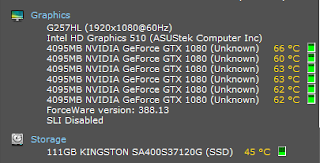Finally built my Crypto Miner.
Nicehash is so easy to use that it is hard to try other miners. Keeping track of wallets is no fun and only needing to deal with Bitcoin simplifies things. Nicehash tries to mine the most profitable currency at the time based on you equipment. Then it pays you in Bitcoin. I would periodically transfer the Nicehash Bitcoin to your hard or paper wallet. I have not decided at what level I would make these transfers.
At first I thought we made a mistake with GTX 1080 cards. They like power and will not mine Equihash without error. When I overclocked the memory, Nicehash wanted to mine Equihash. I had to turn of Equihash mining on each card. This may be caused by the "X" memory in the 1080 cards.
I started with one 1000 watt PSU and added a 750 watt for 6 cards. In the end, pushing the power over 1300-1400 watts to overclock higher only added minimal MH/s. The added watt cost was not worth the small return. However 1000 Watts would not have been sufficient so I did need 2 PSU units.
I have the CPU miner turned off also. It gives more OS headroom when tweaking the setup. I will probably turn it back on when I am no longer changing things. CPU mining adds slightly to the MH/s.
Setting up the rig was straight forward PC building. All the video card risers worked out of the box. I avoided the main PCI-e video slot. I heard somewhere the main slot can cause some confusion. The monitor runs with on board video. BIOS settings need research for specific motherboards to recognize multiple video cards.
The 2 PSU units link with a cheap adapter so they both turn on together. This is not necessary but is convenient.
Even at 60C, 6 cards throw off a lot of heat. I wonder how this will work in the summer?
MSI Afterburner also installs Riva Tuner. Riva would not run with the Afterburner download from MSI on my Windows 10 and I had to get Riva from 3DGuru. Updates to Afterburner have not caused further issues.
**Sometimes when the miner errors or crashes and you start it again, Afterburner's control of specific cards becomes lost. So Afterburner can read 60C but one card can be running hot. This rarely happens. I verify Afterburner settings now and then during tweaking or after crashes to assure it sees and is controlling all the cards. This is only significant when tweaking is causing miner crashes. You may need to reboot the system to get back control of all cards. Speccy.exe is a good way to monitor the video card temps because it easily displays all the card sensors at one time and individually. There will always be individual differences in the card temps like the Speccy below but this is fine. I assume the card reading 66C is the last one in the row receiving all the heat from the other cards but I am not certain.
I use Anydesk to access the rig remotely and it works great.
Is this a good plan to get rich? I suspect not. Crypto mining is always something I have wanted to try. I have always overclocked my PC's and it would have been a natural thing to try. Why I did not is a mystery. But someone came along and offered to buy the expensive video cards and rack if I would buy the rest and build the machine. At $600 per card, I thought it was crazy. I am a PC bottom feeder and prefer using out of favor equipment and tweaking the performance. A 10 month payback is not impressive. My electricity is fairly cheap at .11 per kw and it is deductible as is all the hardware. GTX 1080's will bring a good eBay price for some time to come and I would not mind getting stuck with a "free" GTX 1080 or two in the end.
I'm not sure about the life of a GTX 1080 running 24/7 but I'm not pushing them to the extreme - only because pushing them further brings little additional MH/s.
So . . . the cost of thing is embarrassing.
150 Motherboard ASUS PRIME Z270-A LGA1151
52 CPU Intel BX80662G4400 Pentium Processor G4400 2 core 2 thread
42 Memory Crucial 4GB Single DDR4 2133
177 PSU Corsair RMx Series, RM1000x
100 PSU Corsair RMx Series, RM750x
50 S-Union 6-Pins Pcle VER 006C PCl-E 16x to 1x Powered Riser Adapter Card
3600 video card Gigabyte GeForce GTX 1080 8 GB
15 120 x4 Rosewill fans
15 SilverStone PWM Fan Hub System Cables, Black (CPF04)
60 SSD Drive Kingston Digital, Inc. 120GB A400 SATA
19 P3 P4400 Kill A Watt Electricity Usage Monito (I added another for 2nd PSU)
9 Dual PSU Power Supply 24-Pin ATX Motherboard Adapter Cable(30cm)
6 Push Button ATX Computer Switch Wire (not needed)
??? Rack (I don't know what he paid for the rack but building one would be cheap.)
$4294
I turned on the CPU miner but that is not all the increase. Today the miner was feeling it's oats for some reason.
When mining with the CPU, you may receive a VirtualAlloc failed error.
I did this:
1. With 4 GB of ram, set the Fix the virtual memory allocation at 8 GB. This is standard old school stuff. I have read higher suggestion of 16-20 GB. I'm not sure this is even necessary because the next step fixed the problem.
2. Run gpedit.msc if you have a Pro edition of Windows.
Go to Local Computer Configuration - Windows Settings - Security Settings - Local Policies - User Rights - Lock pages in memory - Add your user name in the setting.
(If you have Windows Home, you do not have gpedit.msc. Policy Plus is a free standing (and free) program to simulate Group Policy Editor but have not tried it.)





